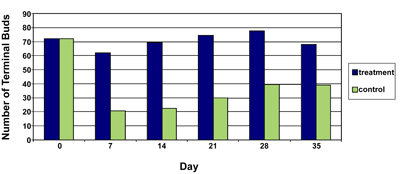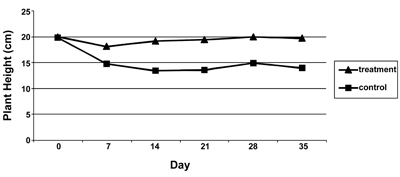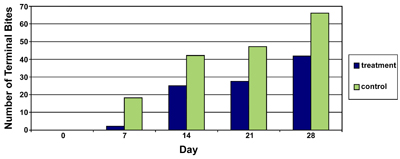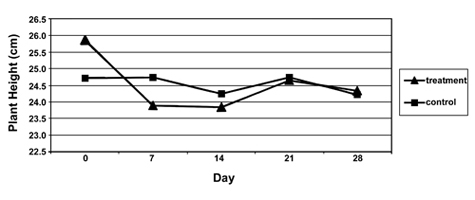Introduction

A growing human population is leading to increased land development. Many homeowners maintain gardens and landscapes around their homes. Often, wildlife and humans come into contact with each other, resulting in damage to human property. Often in these cases, intensive deer management is needed. White-tailed deer provide aesthetic and economic value, but deer can cause a variety of negative economic impacts. Deer can damage personal property, agronomic crops, landscape plantings, and food plots, and they serve as a host for diseases common to livestock and humans.
Unlike some nuisance animals (fire ants, termites, or rats, for example), deer cannot be casually eliminated when conflicts arise. Landowners are often expected to carry the entire burden of support for this public resource. Deer damage control can be a difficult social and political problem as well as a biological and logistical one. Fencing, repellents, and shooting are all considered effective strategies to control deer damage. Many homeowners would like an inexpensive but effective control method to safety reduce deer damage.
Repellents are often used intensively around orchards, gardens, ornamental plants, and agronomic crops. Repellents have limited usefulness with high deer densities. Often, deer density must be reduced prior to achieving success with repellents. New repellents continue to enter the market, but their effectiveness varies. Success is determined based on the reduction of damage, not total elimination. Repellents generally rely on fear, pain, taste, or conditioned avoidance to change deer behavior. Three methods used to deliver repellents: incorporated into the plant (systemic delivery), spread throughout an area (area delivery), and applied to the plant (contact delivery). The effect of repellents varies depending on several factors including deer density, alternate food sources, and changes in plant palatability.
Milorganite® has been suggested as an area repellent for use in the spring and summer in Georgia to control deer damage. We tested the effectiveness of Milorganite® on ornamental plants. The specific objective of this study was to determine the effectiveness of Milorganite® as a temporary deer repellent when applied to established ornamental plants during the summer.
About Milorganite®
In 1913, the legislature in Wisconsin passed an act to create a sewage commission responsible for cleaning up the waterways. During the same year, a chemist in Birmingham, England, was conducting experiments with the biosludge in sewage. The Milwaukee Sewage Commission adopted this new process for use on December 31, 1919. Jones island, on the shore of Lake Michigan, was chosen as the site of the world’s first large-scale activated sludge treatment plant, the Jones Island Wastewater Treatment Plant.
The main purpose of the Jones Island plant was to produce clean water, but they were faced with the problem of disposing of the biosolids left from the activated sludge process. The Milwaukee Metropolitan Sewerage District (MMSD) established a fellowship at the University of Wisconsin College of Agriculture to investigate uses of activated sludge as fertilizer. O. J. Noer was the primary investigator. After experimenting with field crops and vegetables, Noer focused on the use of the organic fertilizer on lawns. Based on his research, Noer concluded that the organic, slow release fertilizer can be safely applied to plants, without the risk of burning, while providing long-lasting results.
The trade name, Milorganite®, was derived from MILwaukee ORGAnic NITrogEn. This product is often used for soil amendment purposes rather than as a fertilizer because of the low Nitrogen-Phosphorus-Potassium (N-P-K) values of 6-2-0. The cost of a 40-lb bag usually runs from $7.00 to $10.00. Milorganite® is commercially sold by fertilizer dealers throughout the United States.
Methods
Research was conducted on the Berry College campus north Georgia. Deer density in the area was estimated by Georgia Department of Natural Resources to be 35-50 deer per square mile. The campus contained two research sites: Campus site and Oak Hill Garden site. At the Campus site, test plants were small and we counted the number of terminal buds prior to planting. Then, at approximately 7-day intervals, we again counted the number of buds to determine the extent of deer damage. The difference in number of buds was an index of deer damage.
At the Oak Hill Garden site, the chrysanthemums were larger with abundant buds so we counted those bud bites at approximately 7-day intervals. A bud bite was recorded if the flower bud was removed from the stalk. All bites were assumed to be due to deer. We also measured the mean plant height for each plant at each site.
Campus Site
Chrysanthemums (C. morifolium var. Sunny Linda) were planted in three plots at the Campus site. The plots were separated by about 400 yards. Each plot contained a row of 10 control and 10 treatment plants 1 ft apart. Rows of the control and the treatment plants were separated by 9 ft.
Prior to planting, all terminal buds were counted, and plants were assigned to respective locations based on the number of terminal buds. Thus the total initial numbers of available terminal buds were similar for each plot. The treatment plants received an application of Milorganite® equal to 0.25 lb (4 oz) per plant. Milorganite® was applied the same day of planting to minimize any pre-test damage done by deer. After planting, the number of existing terminal buds/blooms and plant height to the highest terminal bud (in inches) was recorded for 35 days. Milorganite® was weighed and spread by hand around each plant.
Oak Hill Garden Site
The Oak Hill Garden site was planted with approximately 1,000 chrysanthemums among three plots within established formal garden areas. Each plot contained 20 control and 20 treatment plants. Spacing between mums was similar to the Campus site. However, because of the orientation of the formal gardens, distance between respective control and treatment plants was 30 ft at two of the plots and 60 ft at the third site. The treatment plants received application rate of 4 oz per plant of Milorganite®. Because of the level of plant maturity, we counted the number of bites to terminal flower buds and measured plant height to the tallest terminal bud (inches) for each plant during a 28-day period.
Results
Campus Site
The average number of terminal buds for each plant across the three plots prior to planting was 72.10 (treatment) and 72.23 (control). The average plant height for all plants was also similar (7.5-8.0 in.). Throughout the 35-day trial, the number of terminal buds that remained on the Milorganite® treated plants significantly exceeded the controls (Figure 1). The presence of a greater number of terminal buds at days 21 and 28 compared to the numbers recorded immediately prior to planting is an additional indication that the mums had the opportunity to grow due to limited browsing damage. Average plant height was consistently and significantly higher for the Milorganite® treated mums as compared to respective controls following the initial planting (Figure 2).
 Figure 1. Average number of Chrysanthemum terminal buds present in each plot at 7-day intervals at the Campus site on the Berry College campus during summer, 2004.
Figure 1. Average number of Chrysanthemum terminal buds present in each plot at 7-day intervals at the Campus site on the Berry College campus during summer, 2004. Figure 2. Average height (cm) of Chrysanthemum recorded at 7-day intervals at the Campus site on the Berry College campus, Mt. Berry, GA, summer, 2004.
Figure 2. Average height (cm) of Chrysanthemum recorded at 7-day intervals at the Campus site on the Berry College campus, Mt. Berry, GA, summer, 2004.Oak Hill Garden Site
The average number of terminal bites recorded for Milorganite® treated and control plants across the three plots is presented in Figure 3. While damage recorded as the removal of terminal buds (terminal bud bites) occurred for both treatment and controls, plants treated with Milorganite® had fewer average terminal bud bites. Because of the maturity of the chrysanthemums used at these sites, changes in height would be expected to be more of a function of degree of deer damage as compared to plant growth. While number of terminal bud bites was lower (meaning more buds were unbrowsed) for the treated mums throughout the 28-day trial, average plant height decreased on days 7 and 14 before returning to heights similar to the controls (Figure 4).
 Figure 3. Average number of terminal bites (buds removed by deer) on Chrysanthemum observed at 7-day intervals on Berry College campus (Oak Hill Garden site) during summer, 2004.
Figure 3. Average number of terminal bites (buds removed by deer) on Chrysanthemum observed at 7-day intervals on Berry College campus (Oak Hill Garden site) during summer, 2004. Figure 4. Average height (cm) of Chrysanthemum recorded at 7-day intervals at the Oak Hill Garden site on the Berry College campus, Mt. Berry, GA, summer, 2004.
Figure 4. Average height (cm) of Chrysanthemum recorded at 7-day intervals at the Oak Hill Garden site on the Berry College campus, Mt. Berry, GA, summer, 2004.
Conclusions
From these results, we concluded that Milorganite® has potential as a deer repellent for ornamental plants. Though the repellent did not eliminate deer damage, it reduced the overall impact. The effectiveness of a repellent is highly dependent on climatic conditions, deer density, and resource availability. High deer densities and low resource availability may reduce the efficacy of Milorganite® as a repellent. Reduction of plant damage may further be improved if Milorganite® is reapplied when deer damage is initially observed. Further research involving different application rates and different plant varieties will prove useful in deter-mining the deer’s tolerance level to Milorganite®.
Acknowledgments
Revised in 2024 by Michael T. Mengak. Thanks to the following authors for their contributions to the original manuscript of this publication: Odin L. Stephens, Former Graduate Student; and Karl V. Miller, Professor Emeritus, Wildlife Management, both from UGA's Warnell School of Forestry & Natural Resources. And from Berry College (Georgia): George Gallagher, Dana Professor, Animal Science.
References
Butifiloski, J. W, Hall, D. I., Hoffman, D. M., & Forster, D. L. (1997). White-tailed deer management in a coastal Georgia residential community. Wildlife Society Bulletin, 25, 491-495.
Conover, M. R. (1997). Monetary and intangible valuation of deer in the United States. Wildlife Society Bulletin, 25, 298-305. https://works.bepress.com/michael-conover/53/
Conover, M. R. (2002). Resolving human-wildlife conflicts: The science of wildlife damage management. CRC press. https://doi.org/10.1201/9781420032581
Craven, S. R., & Hygnsorm, S. E. (1994). Deer. In S. E. Hygnstorm, R. M. Timm, & G. E. Larson (Eds.), The handbook: Prevention and control of wildlife damage (pp. D-25–D-40). University of Nebraska Cooperative Extension. https://digitalcommons.unl.edu/icwdmhandbook/47
Kammermeyer, K., Gregory, D., & Williams, E. J. (2008). Controlling deer damage in Georgia. Georgia Department of Natural Resources, Wildlife Resources Division. https://georgiawildlife.com/sites/default/files/wrd/pdf/management/2008_Controlling_Deer_Damage.pdf
Trent, A., Nolte, D., & Wagner, K. (2001). Comparison of commercial deer repellents (Publication No. 0124-2331). U.S. Department of Agriculture, Forest Service, National Technology and Development Program. https://www.fs.usda.gov/t-d/pubs/pdfpubs/pdf01242331/pdf01242331.pdf
Status and Revision History
Published on Sep 15, 2005
Published on Feb 05, 2009
Published on Apr 02, 2009
Published with Full Review on Apr 05, 2012
Published with Full Review on Aug 01, 2017
Published with Minor Revisions on Aug 22, 2024


























































